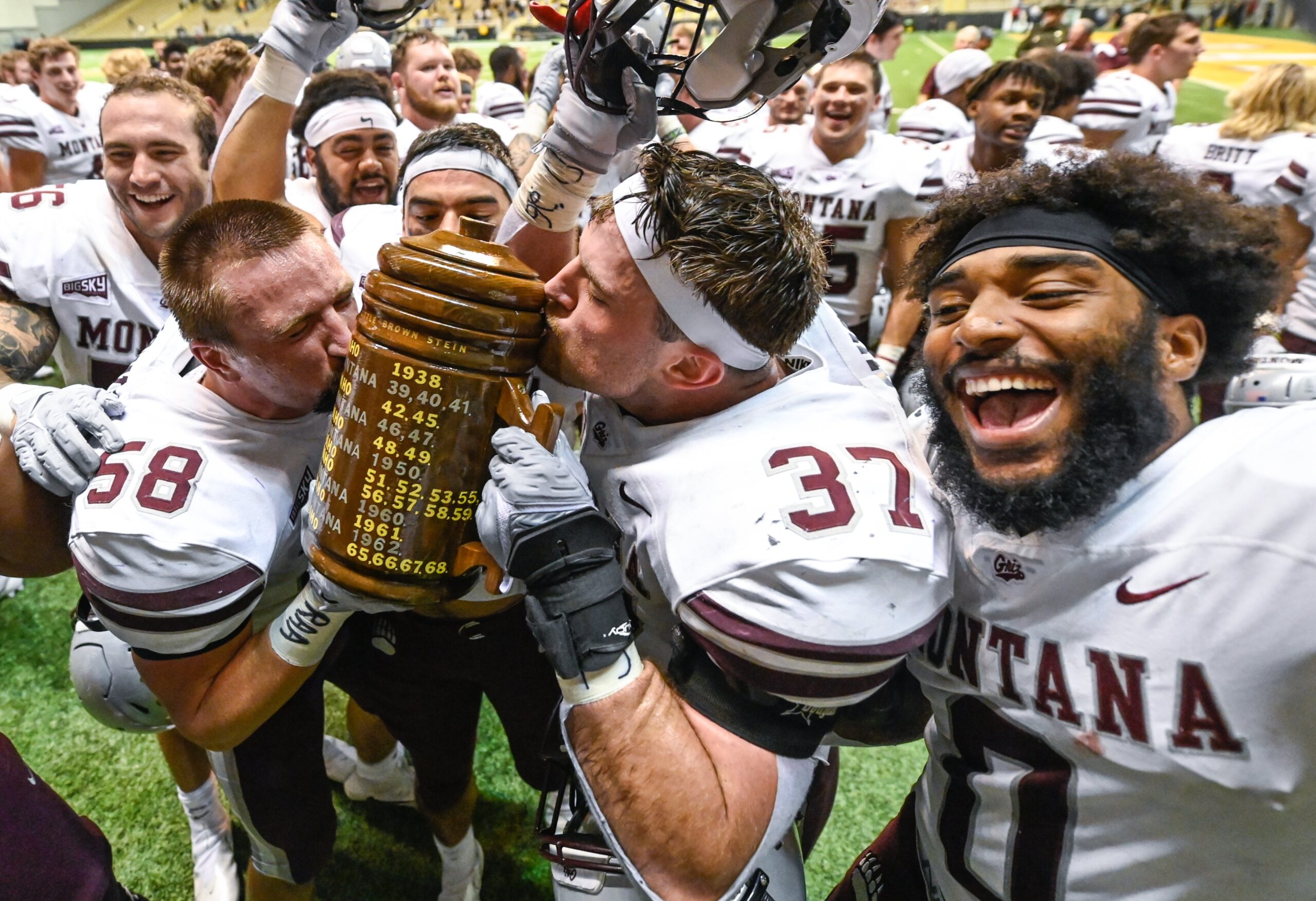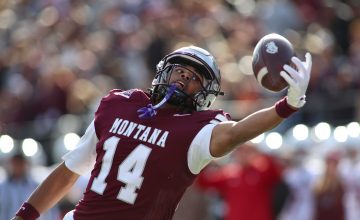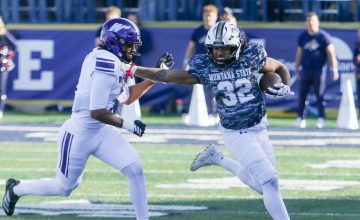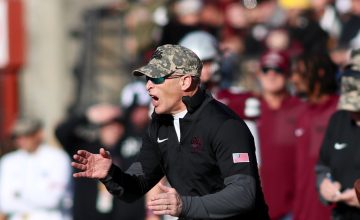MISSOULA, Montana — For many Big Sky Conference football fans, it’s been the Grizzlies or the Eagles or the Bobcats that have been the barometers for success.
For Big Sky football fans of a certain age, the pacesetters used to be different. And for a decade straight starting in 1982, the Idaho Vandals were the cream of the crop in the Big Sky.
The reason this remains relevant is the Vandals are back in the Big Sky Conference and have been since before the 2018 football season. All that 22 years in the FBS yielded was three bowl games (the Vandals did win the Famous Idaho Potato Bowl 61-50 over Colorado State in 2016, two years before dropping down to the FCS) and a whole bunch of feuding alumni over which level of Division I football was the right level for the team from the Kibbie Dome.
Idaho comes to Washington-Grizzly Stadium on Saturday to take on a Montana team that is hoping it’s finally re-ascended to its perch stop the Big Sky summit. The Grizzles owned the league from 1995 until 2009, winning the league title 12 seasons in a row and advancing to the playoffs 17 consecutive times.
Much of that success can be attributed to the UM’s unbelievable home-field advantage and the gem that is Wa-Griz. Much of it stems from Don Read’s innovative offense, Dave Dickenson’s superlative skill and a seemingly never-ending pipeline of in-state talent that came to Montana without scholarships and left to join NFL rosters.
It’s worth acknowledging too that the departure of Boise State and Nevada in 1993 and Idaho in 1995 fundamentally altered the landscape and future of the Big Sky. Montana won the conference five times while Idaho was in the league between 1963 and 1995. UM won the league in 1993 and 1995, the latter preceding Montana’s first national championship run.
The Vandals won the league nine times, including six times between 1982 and 1992, a 10-year span that is widely considered the golden era of UI football.
Who knows how much an influence not having Idaho around had on Montana’s surge to the ranks of the most successful small-school college football programs in the country?
But it’s certain that Montana has owned Idaho ever since the Vandals defeated the Griz 55-43 during that 1995 national championship run. Since then, UM is 7-1 in the “Battle for the Little Brown Stein”, which commences for the 88th time on Saturday afternoon in Missoula. It’s now Idaho chasing Montana, instead of the other way around.

In a rivalry that dates back to 1903, Idaho holds a 55-30-2 advantage. But Montana has won seven in a row, a streak that dates back to 2000. And the Griz have won 11 of 13 matchups dating back to 1991.
When UM head coach Bobby Hauck engineered a 41-28 victory over the Vandals in 2003 (his first season in his first seven-year stint at UM) with scout team quarterback Kyle Samson running the option, UI elected to not play the Griz again until it became a mandated conference game 15 years later.
Montana has beaten Idaho soundly three times since the rivalry was renewed. UM won 46-27 in Moscow in 2018; 42-17 in Missoula in 2019; and 34-14 in Moscow last season.
But new head coach Jason Eck has his team at 2-0 in league play and riding a three-game winning streak. There seems to be more juice around the Vandal program, plain and simple. Even though Moscow is 250 miles away from Missoula, the re-invigoration is palpable.
Maybe that’s what happens when you get to replace Paul Petrino. But that’s here nor there. Idaho has tradition and there’s plenty of trophies in the UI trophy case. A few of the best football players in the league’s history played at Idaho. And the quarterback lineage is deep, including NFL gunslingers like John Friesz and Doug Nussmeier.
Eck is well aware of the tradition he’s trying to repair and continue to harness.
“I have a little sheet on the history of the rivalry and I was shocked to know that Idaho has won more games in this rivalry than Montana because obviously, the last 25 years have not been that way,” Eck said. “I bet nobody in our building would’ve known that. None of our players would’ve known that.
“But we need to embrace that. We had a lot of guys back on homecoming who played in the early 1980s and from 1982 when they brought in Coach Erickson and had a quick turn around, made the playoffs. That’s going to be our goal here this year.”
Idaho used to dominate Montana but that hasn’t been the case since the Griz turned the tide in the early 1990s. Part of Idaho’s rise to national prominence and continued success against UM while still in the Big Sky came from a string of elite offensvie minds serving as head coaches on the Palouse.
Many coaches from the Big Sky Conference went on to climb to the highest heights of college football — none more than Dennis Erickson, a former Montana State quarterback who went on to become a College Football Hall of Famer.
Erickson cut his teeth in Bozeman, first playing quarterback for Jim Sweeney and Tom Parac at MSU and then beginning his coaching career under Sonny Holland for the Bobcats in 1971.
Erickson’s first big-time job came as the offensive coordinator at Idaho on Ed Troxel’s staff in 1974. He then joined Sweeney’s staff at Fresno State in 1976. After a successful three-year stint as the OC at San Jose State between 1979 and 1981, Erickson landed his first head coaching job at Idaho.
The Vandals hadn’t won a Big Sky title since 1971. But Erickson’s innovative single-back offense and his ability to develop quarterbacks, beginning with “the Kamiah Kid” Ken Hobart, helped the Vandals win the conference crown in 1982.
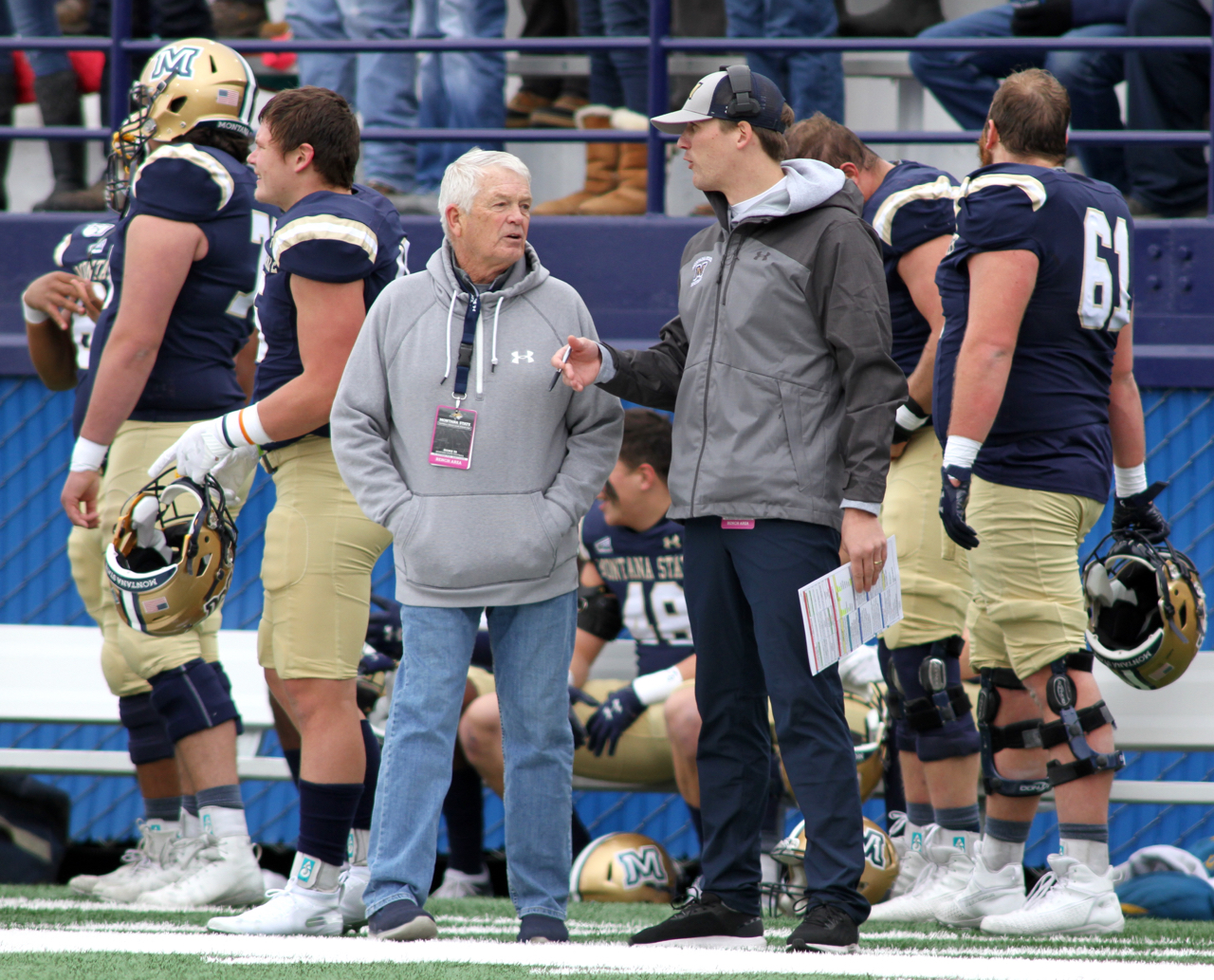
Idaho won the league again in 1985, helping vault Erickson rapidly up the ladder. He spent 1986 at Wyoming, 1987 and 1988 at Washington State before taking over at Miami ahead of the 1989 season. He led the Hurricanes to two national titles before jumping to the NFL in 1995.
Erickson helped lure John Friesz to Moscow, although to hear Friesz tell it, it was the only place he had the option of going. The walk-on from Coeur d’Alene (Friesz was actually born in Missoula and went to one year of school in second grade in the Garden City) went from in-state walk-on to All-American just like Hobart.
Friesz was a first-team All-Big Sky selection at quarterback in 1987, 1988 and 1989. His senior season in 1989, he became the first Big Sky player to earn the Walter Payton Award as the most outstanding player in Division I-AA.
“I had great linemen, great receivers, etc, but a lot of teams have that. What separated us was the coaching,” Friesz said on October 12 on ESPN Missoula. “Coach Erickson came in with a very innovative one-back offense, three wide outs, a tight end, a running back who could receive.
“A lot of that was new to college football. And Montana was one of the first teams that I saw five wideouts. They were innovative as well.”
With Keith Gilbertson as the head coach between 1986 and 1989, the Vandals made the Division I-AA playoffs all four seasons. Idaho also had little trouble beating the Grizzlies. UI beat UM 21 times in 27 matchups between 1965 and 1990. One of those wins came in 1982 in the first round of the playoffs as Erickson’s Vandals kept Montana standout quarterback Marty Mornhinweg and head coach Larry Donovan’s Grizzlies in check in a 21-7 win.
That UI win avenged a 40-13 loss to UM, marking just the fifth time in 17 matchups as conference members that the Griz bested the Vandals.
The ’82 playoff result also served as Erickson’s lone post-season win at Idaho. Friesz and Gilbertson lost 59-30 to Weber State in the first round of the 1987 playoffs. The Vandals made their best run in program history in 1988, beating Montana 38-19 in the first round of the playoffs and beating Northwestern State 38-30 to advance to the semifinals for the first time.
“Coach Gilbertson just continued to grow on what Coach Erickson put in and he put his own flavor on the coaching,” Friesz said. “He was the most fun coach I ever had and that helped him be a great recruiter. We recruited the Northwest really well.”
Even when Gilbertson took the offensive coordinator position at Washington following the 1988 season and Friesz graduated after winning the Payton in 1989, Idaho won the league twice more and advanced to the FCS playoffs five times in six seasons between 1989 and 1994 under John L. Smith.
Between 1982 and 1995, Idaho won the Big Sky Conference six times and qualified for the FCS playoffs 10 times. UI went 86-174 during its time in the FBS, a win percentage of just .331. UI had just four winning seasons in 23 years playing at the highest level of Division I.
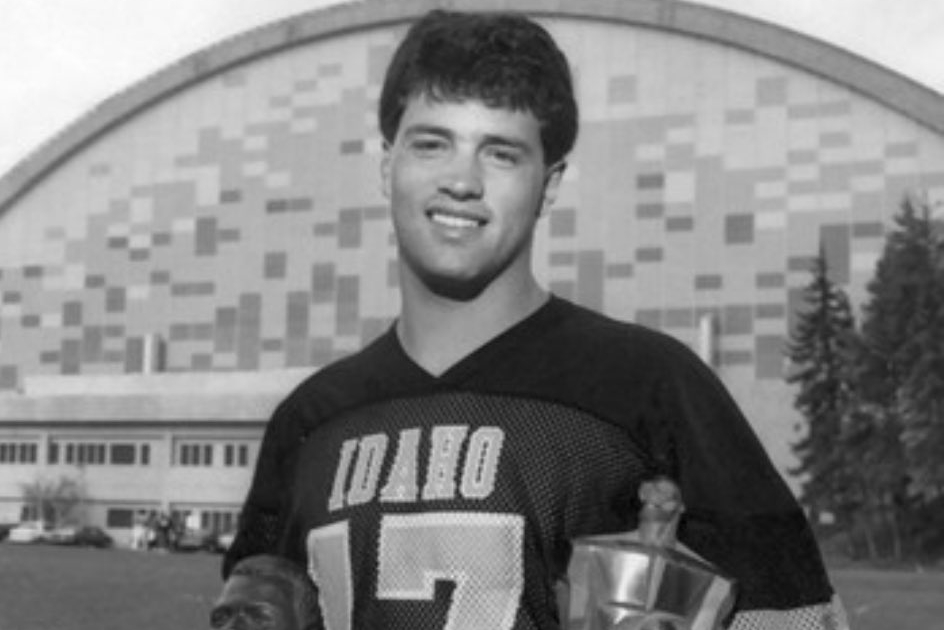
“As far the conference and how we compared nationally, we were spreading it out, Montana did it and taught a lot of people and the entire conference was pass-friendly,” Friesz said. “There was a lot of domes. And we would keep learning from each other.
“Yards, stats and passing continued to get better each year. It was a complete progress, especially at Idaho with what Hobart did and Scott Linehan and then what I did, then Doug Nussmeier broke all those records. It kept getting better.
“On the national level, other conferences couldn’t line up with what we were doing on offense. Boise State took advantage of it with a national title (1980) and a title game appearance (1994). Idaho State did the same (1981) and those things continued to make the Big Sky Conference powerful.”
One of the rare Griz wins of Idaho’s golden era came during that 1988 regular season. The 26-17 loss is one that sticks out in Friesz’s mind and served as UI’s only regular-season loss in a season the Vandals finished 11-2.
“It was definitely one of the top two games on our schedule every year, along with Boise State, sort of like Montana-Montana State,” Friesz said. “Montana was the other team that always gave us fits and the team that we first played on ESPN, which back then was pretty cool because there wasn’t five different ESPN channels.
“I remember Tim Hauck, we were the same age and teammates in the NFL for years, so there was always a little banter playing against each other because he was so good. And my memory of those games of how I beat him is different than his recollection. But certainly one of my worst games was at Montana. I threw four interceptions and I threw the walkoff interception at the end of the game. I have a horrible memory of it.”
Bobby Hauck was also in his first season as a graduate assistant on Read’s staff back in 1988.
“I remember back in 1988, Coach Read hadn’t beat them before and we went to 4-0 for the first time in forever,” Hauck said with a smile. “I remember they had a chance to win it and went for 2 and he (John Friesz) threw a pick-6.”
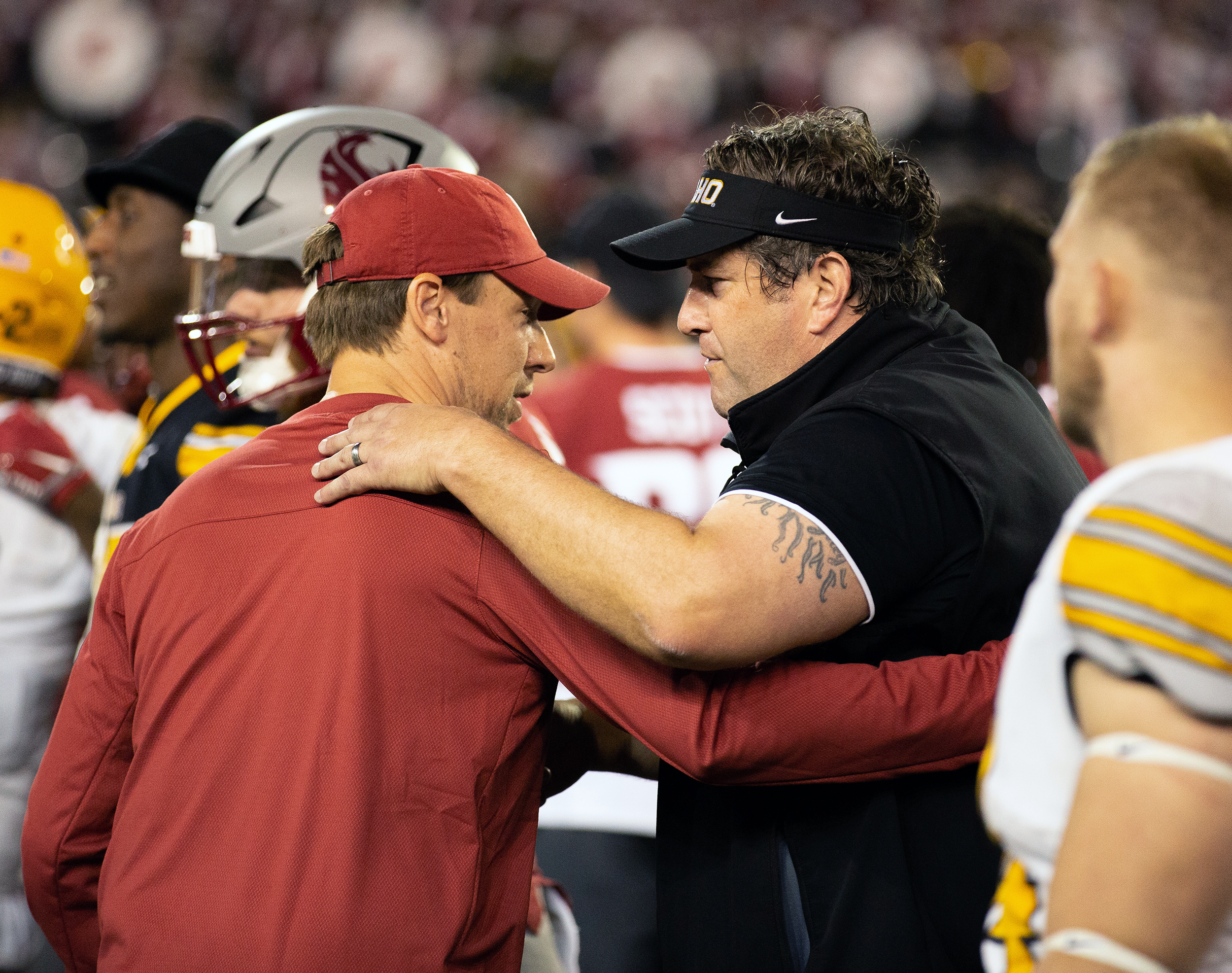
Since 1991, the Vandals have beaten the Griz twice in the 13 match-ups. The Griz won four straight between 1991 and 1994. Idaho’s parting gift to UM in 1995 was a 55-43 win at the Kibbie Dome that served as UM’s second and final loss that season. The Battle for the Little Brown Stein didn’t commence again until 1999 and UI inched out a 33-30 win.
Montana defeated Idaho four years in a row between 2000 and 2003, including wins in Pullman in 2000 and Moscow in 2002 before the series was halted.
UM has not won a Big Sky title since 2011 but the Griz made runs to the quarterfinals of the playoffs in 2019 and 2021. Idaho has not had a winning record since returning to the league. UI is 24-38 over the last four seasons, including 3-5 Big Sky records in each fall season in 2018, 2019 and 2021.
“They look similar,” Hauck stated. “Everybody is doing the same things on offense. But they look similar. They are not reinventing the wheel. They are playing hard. They look really physical, which is certainly like they have been. They look like they are enjoying the game and having fun playing.”
Saturday afternoon in Missoula is being looked at as the final tune-up by many before the Griz embark on a gauntlet in the second half of this season that includes trips to No. 4 Sacramento State and No. 5 Weber State to finish October.
For the Vandals, Saturday is an opportunity to reignite a rivalry and prove that the reinvigoration is real.
“This week has been an education for our whole program because I don’t know if anyone on our team has ever seen this thing (the Little Brown Stein) in person,” Eck said when asked about the rivalry.
“We had to learn about the history of the rivalry. I don’t know if this is going to be the year, because they are damn good, but I’m hoping over time, we can make a rivalry again.”
Photos by Brooks Nuanez and attributed. All Rights Reserved.

